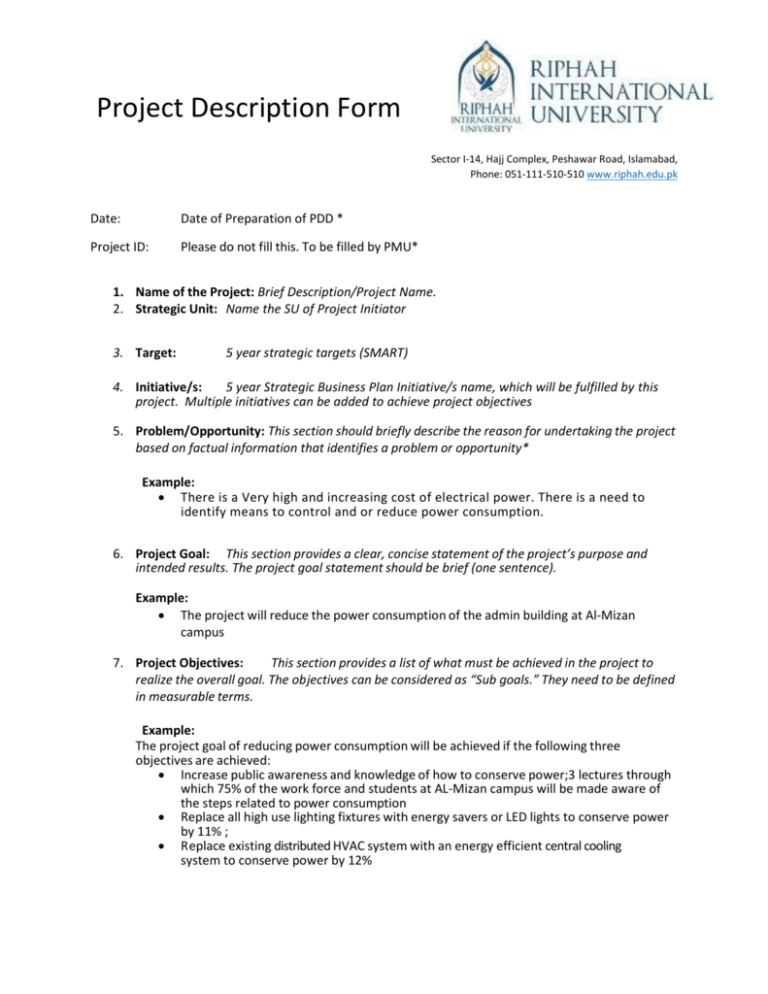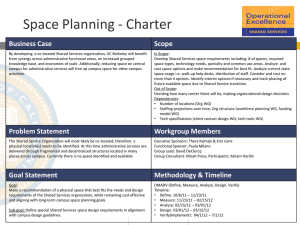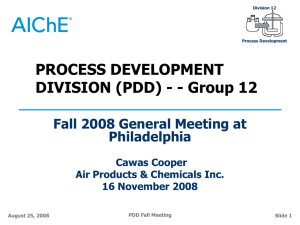Project Description Form Sector I-14, Hajj Complex, Peshawar Road
advertisement

Project Description Form Sector I-14, Hajj Complex, Peshawar Road, Islamabad, Phone: 051-111-510-510 www.riphah.edu.pk Date: Date of Preparation of PDD * Project ID: Please do not fill this. To be filled by PMU* 1. Name of the Project: Brief Description/Project Name. 2. Strategic Unit: Name the SU of Project Initiator 3. Target: 5 year strategic targets (SMART) 4. Initiative/s: 5 year Strategic Business Plan Initiative/s name, which will be fulfilled by this project. Multiple initiatives can be added to achieve project objectives 5. Problem/Opportunity: This section should briefly describe the reason for undertaking the project based on factual information that identifies a problem or opportunity* Example: There is a Very high and increasing cost of electrical power. There is a need to identify means to control and or reduce power consumption. 6. Project Goal: This section provides a clear, concise statement of the project’s purpose and intended results. The project goal statement should be brief (one sentence). Example: The project will reduce the power consumption of the admin building at Al-Mizan campus 7. Project Objectives: This section provides a list of what must be achieved in the project to realize the overall goal. The objectives can be considered as “Sub goals.” They need to be defined in measurable terms. Example: The project goal of reducing power consumption will be achieved if the following three objectives are achieved: Increase public awareness and knowledge of how to conserve power;3 lectures through which 75% of the work force and students at AL-Mizan campus will be made aware of the steps related to power consumption Replace all high use lighting fixtures with energy savers or LED lights to conserve power by 11% ; Replace existing distributed HVAC system with an energy efficient central cooling system to conserve power by 12% 8. Key Deliverables: This section provides a high level list of the major deliverables. Include basic quantity and specification to describe the key deliverables. Objectives imply quantification of performance whereas Projects produce DELIVERABLES (sometimes called Products, or Outputs). Example: Energy conservation plan duly vetted by an electrical consultant of the admin building of Al-Mizan campus A manual for SOPs relating to usage of air conditioning Installation of 200 LED lights providing 11% power conservation Installed central HVAC system catering for admin building at Al-Mizan campus. Sale of all replaced equipment made redundant from the project. 3 lectures with planned attendance conducted. Certificates given to the employee attending the lecture. 9. Key Stakeholders: This section provides a list of the people with the strongest interest in or influence over project work and results. Examples: Decision-makers: People with authority and decision-making power over the project. PC/ED/VC/SU head, Project Manager of the project, FU heads etc Influencers: People with power to influence the project. FU heads, execution team, suppliers, regulatory body etc End users: People who will use the end product of the project. Student, faculty, staff etc 10. Assumptions: This section lists the project’s assumptions. Assumptions are factors outside the scope of the project that could affect its success and which the authors of this document believe to be true. Examples: Availability of LED lights in Pakistan Availability of funds through approval of project On time delivery of imported HVAC system Availability of power to run the HVAX system Appropriate resources will be available to work on the project. Higher Management will give full financial support for completion of this project. 11. Constraints: This section lists the project’s constraints. Constraints are factors that restrict the project team’s options. Examples: Change in WAPDA power regulations Change in Government regulation related to subsidy on power saving products 12. Risks: This section lists project risks. Risks are something that may or may not happen in the future that could have a negative impact on the project. Examples: Increased load shedding on operations Product failure on operations Shortage of required equipment at the time of purchase 13. Estimated Cost: Provide an initial estimate of what the project is expected to cost. Note that this estimate will be refined during the development of a more detailed Project Plan. Proposed required budget; to be filled after consultation with Procurement (For Materials/ Equipment) BOQ with estimates for civil works from works department (BOQ to be attached) Other ESTIMAES* related documents to be attached with PDD 14. Estimated Duration: Provide an initial estimate of the project duration. Note that this estimate will be refined during the development of a more detailed Project Plan. 15. Must have Start Date 16. End date of the Project 17. Success Criteria: This section provides statements about the impact the project must have on those outside the project to be considered successful. These statements should be consistent with the project goal and provide information on measurable project outcomes. Examples: 15% reduction in Admin Building electricity bills Increased level of ownership with student/faculty/employee satisfaction validated by survey. 75% 18. Strategic Themes / Priorities: Strategic Theme / Priority to be added in this column separately. Various Objectives to be achieved from this Project in line with Long Term Outcome of the strategic Priority/ Theme mentioned in the left column Prepared by: Name of the person who prepared the document (End User/Technical Person) Reviewed by: Name of the person who approved the draft PDD (HOD/SU Head) Approved by: Internal Sponsors: Executive Director for projects under IIMC-T, vice Chancellor for Projects under RIPHAH, DMT Or other Organizations/donor agency name for external Sponsors & Approving Authority






